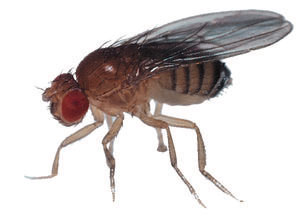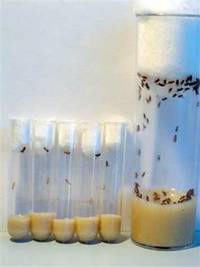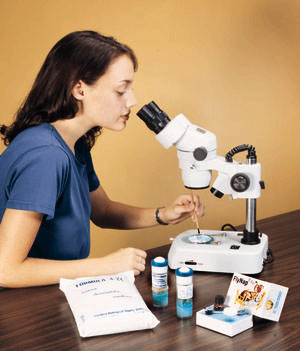Fruit Fly Genetics
In this virtual lab we will cross various fruit flies to see what phenotypes are present in the F1 and F2 generation. Using the data from these crosses, we will make a hypothesis regarding the genotypes of the parental (P) generation and test the hypothesis using a chi square analysis.
**Print out a copy of the Data
Page
**Review how to do a chi
square analysis
Background Information
Drosophila melanogaster is a fruit fly, a little insect about 3mm long, of the kind that accumulates around spoiled fruit. It is also one of the most valuable of organisms in biological research, particularly in genetics and developmental biology. Drosophila has been used as a model organism for research for almost a century, mainly because it is practical: it's a small animal, with a short life cycle of just two weeks, and is cheap and easy to keep large numbers. Mutant flies, with defects in any of several thousand genes are available, and the entire genome has recently been sequenced.
You can order mutant fruit flies from any biological company and perform crosses in the lab that will generally take about two weeks. The fruit fly lab is a staple of many high school and college biology courses.
How to Raise Fruit Flies
1. Order your fruit flies from a
biological supply company (Carolina,
Wards, Etc..)
2. Place the flies in vials containing culture medium (food)
3. Remove the flies you choose for mating and place in a new vial.
4. Remove adults (after mating) and wait for the adults to emerge. Fruit flies
have a life cycle like
all insects.
5. Anesthetize the adults (using either a cold pack or ether) and sort with
a paint brush into piles of flies that have the same characteristics. A stereoscope
is needed to see details.


Terminology
Wild-type - flies that have the "normal" characteristics, red eyes, normal length wing and brown bodies.
Mutant flies - any variation from the wild type. Mutant alleles can be carried on autosomes or sex chromosomes.
Genetic Notation
Mutant flies are given names that generally denote the type of mutation the fly exhibits. For example, the mutant "ebony" has a much darker body than the wild type fly. Each mutation is also given a letter code. Thus, in the case of ebony, the code is a lower case e. The wild type fly is denoted by a superscript + over the mutant letter code. For example, e+ denotes a wild type fly for the ebony body trait - meaning it has normal body color (not ebony). The above description is for a gene located on an autosome (a non-sex chromosome). Of course, fruit flies also have sex chromosomes and they contain a subset of genes as well. The genotypic notation for a mutant gene for white eye color on the X chromosome would look like:
Xw Xw = white-eyed female
Xw+Xw = wild type heterozygote female
Xw Y = white-eyed male
Xw+ Y = wild type male
Simple Virtual Crosses
Data Analysis -
Sort and view outcomes of different crosses (virtual)
- Wild Type Female x Vestigial wing male
- Wild Type Female x White eyed male (sex linked)
- White eyed female x Wild type male
Virtual Fruit Fly Labs
FRuit Fly (Drosophila) Virtual Lab – more extensive virtual lab through a program created by Virtual Courseware, requires set up by teacher.
